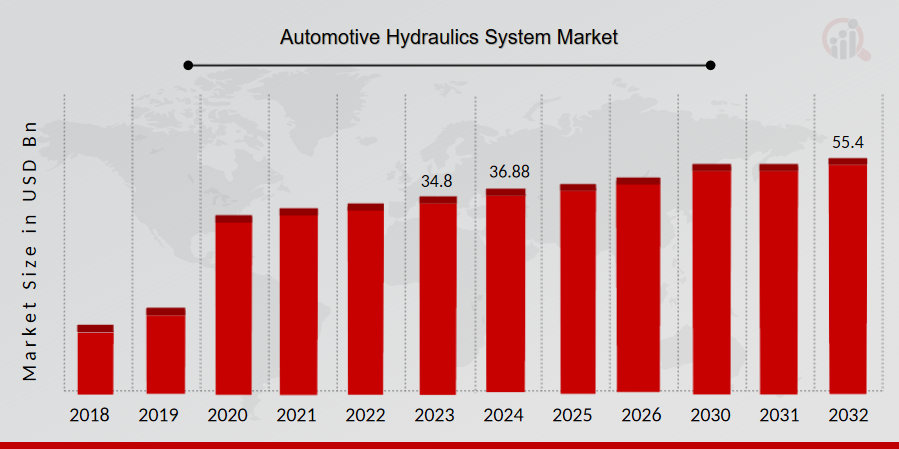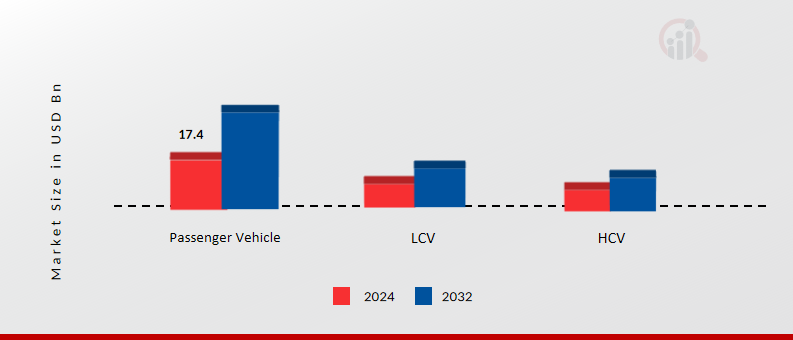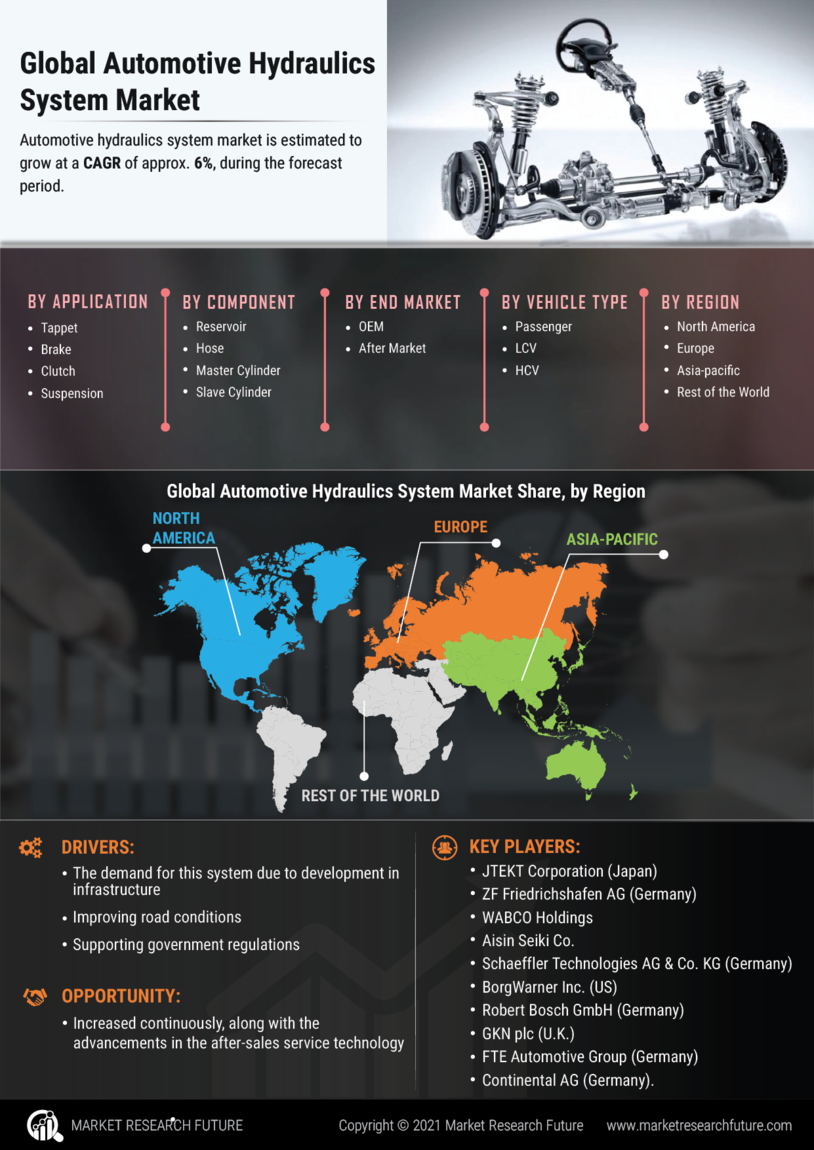Automotive Hydraulics System Market Overview:
Automotive Hydraulics System Market Size was valued at USD 34.8 Billion in 2023. The automotive hydraulics system market industry is projected to grow from USD 36.88 Billion in 2024 to USD 55.4 Billion by 2032, exhibiting a compound annual growth rate (CAGR) of 5.22% during the forecast period (2024 - 2032). Increasing vehicle production, rise in off-road vehicle sales and innovations in electrohydraulic automotive applications are the key market drivers enhancing the market growth.

Source: Secondary Research, Primary Research, MRFR Database and Analyst Review
Automotive Hydraulics System Market Trends
Increasing demand for commercial vehicles is driving the market growth
A rise in sales of commercial vehicles drives market CAGR for automotive hydraulics system. Due to the growth of the industrial sector globally and the rising number of construction and e-commerce operations, there was an increase in the need for material transportation, which led to an increase in commercial vehicle sales. The market for vehicle hydraulic systems is likely to be driven by this.
Commercial vehicles are regularly subjected to large loads over vast distances throughout the year. This necessitates that the vehicle be fitted with equipment capable of withstanding huge loads without sacrificing fuel efficiency and production.
Because they contain fewer moving components than electric systems, hydraulic systems are straightforward, secure, and affordable. This gives hydraulic systems a competitive advantage over electric systems, and the electrification of passenger vehicles is anticipated shortly. Commercial vehicles are expected to utilize hydraulic systems, which might allow them to take up a sizable portion of the hydraulic systems industry. Thus, driving the automotive hydraulics system market revenue.
There is growing interest in intelligent hydraulic equipment, and several businesses in the hydraulic ecosystem continue to invest in R&D projects to create more advanced hydraulic equipment and offer consumers better options. As an example, the Z.F. Group introduced integrated brake control (IBC), a non-vacuum, integrated electro-hydraulic brake apply control unit that may take the role of the electronic stability control, vacuum booster, and vacuum pump, as well as any associated cables, sensors, switches, and controllers. It covers fuel-efficient power trains and provides regenerative braking in a single, integrated device without additional vacuum pumps. One of the key advancements, the development of intelligent hydraulic equipment units, will fuel the market's expansion.
Automotive Hydraulics System Market Segment Insights:
Automotive Hydraulics System Application Insights
Based on application, the Automotive Hydraulics System market segmentation includes tappet, brake, clutch and suspension. The brake category will make the most extensive use of this system in terms of applicability. This is because hydraulic system integration in suspension systems has a well-established track record. On the other hand, brake technology has seen several good technological advancements, with hydraulic braking currently being the most effective option.
Automotive Hydraulics System Component Insights
The Automotive Hydraulics System market segmentation, based on components, includes reservoir, hose, master cylinder, and slave cylinder. In 2022, the slave cylinder category led the overall market for automotive hydraulics systems. The slave cylinder will most frequently use a hydraulic system. This is due to the slave cylinder's wide range of uses, including in the clutch, gear mechanism, and disc brake systems, where it converts mechanical pressure into the proper hydraulic pressure applied to the disc brake pads.
Automotive Hydraulics System End Market Insights
Based on the end market, the Automotive Hydraulics System market segmentation includes OEM and aftermarket. In 2022, the OEM category led the overall market for automotive hydraulics systems. Since global car production has expanded steadily and after-sales service technological developments, OEM and aftermarket have equal potential for growth.
Automotive Hydraulics System Vehicle Type Insights
The Automotive Hydraulics System market segmentation, based on vehicle type, includes passenger vehicles, LCVs and HCV. In 2022, the passenger vehicle category led the overall market for automotive hydraulics systems. The rising demand for passenger vehicle advanced components drives this market segment. Additionally, passenger automobiles must adhere to stricter safety rules than commercial vehicles. These elements are behind the expansion of the passenger vehicle market.
Figure 1: Automotive Hydraulics System Market by Vehicle Type, 2024 & 2032 (USD Billion)

Source: Secondary Research, Primary Research, MRFR Database and Analyst Review
Automotive Hydraulics System Regional Insights
By region, the study provides market insights into North America, Europe, Asia-Pacific and the Rest of the World. Up until 2032, Asia Pacific is expected to maintain its market dominance. The region's rising population and urbanization are the main factors driving the automotive hydraulics system market expansion there. The demand for passenger cars has surged due to China's emergence as a major global manufacturing center. The accessibility of raw materials and cheap labor boosts the production of automotive hydraulics systems in the region.
Further, the major countries studied in the market report are The US, Canada, German, France, the U.K., Italy, Spain, China, Japan, India, Australia, South Korea, and Brazil.
Figure 2: Automotive Hydraulics System Market Share By Region 2024 (USD Billion)

Source: Secondary Research, Primary Research, MRFR Database and Analyst Review
Europe's hydraulics system market accounts for the second-largest market share as many automotive OEMs in the region are focused on development of advanced hydraulic system for passenger vehicles. Further, the German automotive hydraulics system market held the largest market share, and the U.K. automotive hydraulics system market was the fastest-growing market in the European region.
From 2024 to 2032, North America's Automotive Hydraulics System Market is anticipated to have the quickest growth. Additionally, Canada's North American automobile hydraulics system market was expanding at the fastest rate, while the U.S. hydraulics system market had the biggest market share. The United States has one of the largest vehicle markets in the world. For the fourth year, light vehicle sales in the United States reached 17 million units. The United States is the second-largest market for automotive sales and production worldwide. U.S. affiliates of vehicle companies with a predominately foreign ownership base hold more than 400,000 American jobs. Additionally, many automakers have facilities in the country for engine and gearbox design, R&D, testing, and manufacturing.
Automotive Hydraulics System Key Market Players & Competitive Insights
Leading market players are investing heavily in research and development to expand their product lines, which will help the automotive hydraulics system market grow even more. Market participants are also undertaking various strategic activities to expand their global footprint, with important market developments including new product launches, contractual agreements, mergers and acquisitions, higher investments, and collaboration with other organizations. The automotive hydraulics system industry must offer cost-effective items to expand and survive in a more competitive and rising market climate.
Manufacturing locally to minimize operational costs is one of the key business tactics manufacturers use in the Automotive Hydraulics System industry to benefit clients and increase the market sector. The automotive hydraulics system industry has offered some of the most significant advantages in recent years. Major players in the automotive hydraulics system market, including JTEKT Corporation (Japan), GKN plc (U.K.), Z.F. Friedrichshafen AG (Germany), Aisin Seiki Co., Ltd. (Japan), Schaeffler Technologies AG & Co. K.G. (Germany), WABCO Holdings, Inc. (U.S.), BorgWarner Inc. (U.S.), FTE Automotive Group (Germany), Robert Bosch GmbH (Germany), and Continental AG (Germany) are attempting to increase market demand by investing in research and development operations.
With its headquarters in Friedrichshafen, in the south-western German state of Baden-Württemberg, Z.F. Friedrichshafen AG, better known as Z.F. Group and formerly Zahnradfabrik Friedrichshafen, is a global technology firm that provides systems for passenger automobiles, commercial vehicles, and industrial technologies. It has a focus on engineering and is largely recognized for its design, R&D, and production work in the automotive sector. It is a major chassis and driveline technology supplier for cars and trucks, as well as specialized plant machinery like construction equipment. In addition to normal industrial applications, it is also involved in the rail, maritime, defense, and aviation industries. Z.F. employs over 165,000 people across 168 production sites in 32 nations. WABCO was acquired by Z.F. in 2020 and will become a part of Z.F. as its Commercial Vehicle Control Systems Division.
Bosch, often known as Robert Bosch GmbH, is a global German engineering and technology firm headquartered in Gerlingen, Germany. Robert Bosch established the business in Stuttgart in 1886. The philanthropic organization Robert Bosch Stiftung owns 94% of Bosch. The charity has no voting rights, is involved in health and social issues unrelated to Bosch's business, and is funded by holding most of the company's shares. The four business segments of mobility (hardware and software), consumer products (including home appliances and power tools), industrial technology (including drive and control), and energy and building technology make up Bosch's key operational areas. Bosch acquired Seeo, Inc., a startup focused on solid-state lithium-ion batteries, in 2015.
Key Companies in the automotive hydraulics system market include
- JTEKT Corporation (Japan)
- ZF Friedrichshafen AG (Germany)
- WABCO Holdings Inc. (U.S.)
- Aisin Seiki Co. Ltd. (Japan)
- Schaeffler Technologies AG & Co. KG (Germany)
- BorgWarner Inc. (U.S.)
- Robert Bosch GmbH (Germany)
- GKN plc (U.K.)
Automotive Hydraulics System Industry Developments
February 2021: With intelligently linked hydraulics, Bosch Rexroth India highlighted its product range for the Indian automotive industry. According to the company, these systems have predictive analytics and aid in proactive maintenance.
January 2018: Integrated brake control (IBC), a non-vacuum, integrated electro-hydraulic brake application control unit that can take the role of electronic stability control, vacuum booster and vacuum pump, as well as accompanying cables, sensors, switches and controllers, was introduced by Z.F. Group. It covers fuel-efficient power trains and provides regenerative braking in a single, integrated device without additional vacuum pumps. IBC manufacture, according to the business, began in 2018.
Automotive Hydraulics System Market Segmentation:
Automotive Hydraulics System Application Outlook
- Tappet
- Brake
- Clutch
- Suspension
Automotive Hydraulics System Component Outlook
- Reservoir
- Hose
- Master Cylinder
- Slave Cylinder
Automotive Hydraulics System End Market Outlook
Automotive Hydraulics System Vehicle Type Outlook
- Passenger Vehicle
- LCV
- HCV
Automotive Hydraulics System Regional Outlook
North America
Europe
- Germany
- France
- UK
- Italy
- Spain
- Rest of Europe
Asia-Pacific
- China
- Japan
- India
- Australia
- South Korea
- Australia
- Rest of Asia-Pacific
Rest of the World
-
Middle East
-
Africa
-
Latin America
| Report Attribute/Metric |
Details |
| Market Size 2023 |
USD 34.8 Billion |
| Market Size 2024 |
USD 36.88 Billion |
| Market Size 2032 |
USD 55.4 Billion |
| Compound Annual Growth Rate (CAGR) |
5.22% (2024-2032) |
| Base Year |
2023 |
| Market Forecast Period |
2024-2032 |
| Historical Data |
2018- 2023 |
| Market Forecast Units |
Value (USD Billion) |
| Report Coverage |
Revenue Forecast, Market Competitive Landscape, Growth Factors, and Trends |
| Segments Covered |
Material Type, Vehicle Type, and Region |
| Geographies Covered |
North America, Asia Pacific, Europe, and the Rest of the World |
| Countries Covered |
The US, Canada, German, France, UK, Italy, Spain, China, Japan, India, Australia, South Korea, and Brazil |
| Key Companies Profiled |
JTEKT Corporation (Japan), GKN plc (U.K.), ZF Friedrichshafen AG (Germany), Aisin Seiki Co., Ltd. (Japan), Schaeffler Technologies AG & Co. KG (Germany), WABCO Holdings, Inc. (U.S.), BorgWarner Inc. (US), FTE Automotive Group (Germany), Robert Bosch GmbH (Germany), and Continental AG (Germany) |
| Key Market Opportunities |
Increasing sales of commercial vehicles |
| Key Market Dynamics |
Increase in premium car sales driving development in automotive hydraulic systems. |
Automotive Hydraulics System Market Highlights:
Frequently Asked Questions (FAQ) :
The Automotive Hydraulics System market size was valued at USD 34.8 Billion in 2023.
The Automotive Hydraulics System market is projected to grow at a CAGR of 5.22% during the forecast period, 2024-2032.
Asia Pacific had the largest share in the Automotive Hydraulics System market.
The key players in the market are JTEKT Corporation (Japan), GKN plc (U.K.), Z.F. Friedrichshafen AG (Germany) and Aisin Seiki Co., Ltd. (Japan).
The brake category dominated the automotive hydraulics system market in 2022.
The passenger vehicle had the largest Automotive Hydraulics System market share.


















